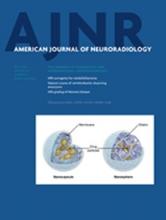Index by author
Honarmand, A.R.
- EDITOR'S CHOICEBrainYou have accessPerfusion-Based Selection for Endovascular Reperfusion Therapy in Anterior Circulation Acute Ischemic StrokeS. Prabhakaran, M. Soltanolkotabi, A.R. Honarmand, R.A. Bernstein, V.H. Lee, J.J. Conners, F. Dehkordi-Vakil, A. Shaibani, M.C. Hurley and S.A. AnsariAmerican Journal of Neuroradiology July 2014, 35 (7) 1303-1308; DOI: https://doi.org/10.3174/ajnr.A3889
The authors attempted to determine if reperfusion therapy for anterior circulation acute stroke based on MR perfusion resulted in better outcomes at 3 months than that based on noncontrast CT. Perfusion imaging-selected patients had a better outcome than those selected with only noncontrast CT but MR perfusion- and CT perfusion-selected patients had similar outcomes. In this multicenter study, patients with acute stroke who underwent perfusion imaging were more than 2-fold more likely to have good outcomes following endovascular reperfusion therapy
Hung, S.-C.
- Patient SafetyYou have accessArtifact Reduction of Different Metallic Implants in Flat Detector C-Arm CTS.-C. Hung, C.-C. Wu, C.-J. Lin, W.-Y. Guo, C.-B. Luo, F.-C. Chang and C.-Y. ChangAmerican Journal of Neuroradiology July 2014, 35 (7) 1288-1292; DOI: https://doi.org/10.3174/ajnr.A3851
Hunt, C.H.
- Head & NeckYou have accessImmunoglobulin G4–Related Disease of the Orbit: Imaging Features in 27 PatientsC.A. Tiegs-Heiden, L.J. Eckel, C.H. Hunt, F.E. Diehn, K.M. Schwartz, D.F. Kallmes, D.R. Salomão, T.E. Witzig and J.A. GarrityAmerican Journal of Neuroradiology July 2014, 35 (7) 1393-1397; DOI: https://doi.org/10.3174/ajnr.A3865
Hurley, M.C.
- EDITOR'S CHOICEBrainYou have accessPerfusion-Based Selection for Endovascular Reperfusion Therapy in Anterior Circulation Acute Ischemic StrokeS. Prabhakaran, M. Soltanolkotabi, A.R. Honarmand, R.A. Bernstein, V.H. Lee, J.J. Conners, F. Dehkordi-Vakil, A. Shaibani, M.C. Hurley and S.A. AnsariAmerican Journal of Neuroradiology July 2014, 35 (7) 1303-1308; DOI: https://doi.org/10.3174/ajnr.A3889
The authors attempted to determine if reperfusion therapy for anterior circulation acute stroke based on MR perfusion resulted in better outcomes at 3 months than that based on noncontrast CT. Perfusion imaging-selected patients had a better outcome than those selected with only noncontrast CT but MR perfusion- and CT perfusion-selected patients had similar outcomes. In this multicenter study, patients with acute stroke who underwent perfusion imaging were more than 2-fold more likely to have good outcomes following endovascular reperfusion therapy
Hurubeanu, L.
- Head & NeckOpen AccessRole of Mastoid Pneumatization in Temporal Bone FracturesA. Ilea, A. Butnaru, S.A. Sfrângeu, M. Hedeşiu, C.M. Dudescu, P. Berce, H. Chezan, L. Hurubeanu, V.E. Trombiţaş, R.S. Câmpian and S. AlbuAmerican Journal of Neuroradiology July 2014, 35 (7) 1398-1404; DOI: https://doi.org/10.3174/ajnr.A3887
Ikka, L.
- NeurointerventionYou have accessRole of C-Arm VasoCT in the Use of Endovascular WEB Flow Disruption in Intracranial Aneurysm TreatmentJ. Caroff, C. Mihalea, H. Neki, D. Ruijters, L. Ikka, N. Benachour, J. Moret and L. SpelleAmerican Journal of Neuroradiology July 2014, 35 (7) 1353-1357; DOI: https://doi.org/10.3174/ajnr.A3860
Ilea, A.
- Head & NeckOpen AccessRole of Mastoid Pneumatization in Temporal Bone FracturesA. Ilea, A. Butnaru, S.A. Sfrângeu, M. Hedeşiu, C.M. Dudescu, P. Berce, H. Chezan, L. Hurubeanu, V.E. Trombiţaş, R.S. Câmpian and S. AlbuAmerican Journal of Neuroradiology July 2014, 35 (7) 1398-1404; DOI: https://doi.org/10.3174/ajnr.A3887
Irie, K.
- FELLOWS' JOURNAL CLUBNeurointerventionYou have accessNatural Course of Dissecting Vertebrobasilar Artery Aneurysms without StrokeN. Kobayashi, Y. Murayama, I. Yuki, T. Ishibashi, M. Ebara, H. Arakawa, K. Irie, H. Takao, I. Kajiwara, K. Nishimura, K. Karagiozov and M. UrashimaAmerican Journal of Neuroradiology July 2014, 35 (7) 1371-1375; DOI: https://doi.org/10.3174/ajnr.A3873
More than 100 conservatively managed nonstroke dissecting vertebrobasilar artery aneurysms were followed on average for 3 years. Ninety-seven percent of patients remained clinically unchanged and the 3 patients who deteriorated clinically had aneurysm enlargement. The natural course of these lesions suggests that acute intervention is not always required and close follow-up without antithrombotic therapy is reasonable. Patients with symptoms due to mass effect or aneurysms of >10 mm may require treatment.
Ishak, G.E.
- PediatricsYou have accessThe Diagnostic Value of CT Myelography, MR Myelography, and Both in Neonatal Brachial Plexus PalsyR. Tse, J.N. Nixon, R.S. Iyer, K.A. Kuhlman-Wood and G.E. IshakAmerican Journal of Neuroradiology July 2014, 35 (7) 1425-1432; DOI: https://doi.org/10.3174/ajnr.A3878
Ishibashi, T.
- FELLOWS' JOURNAL CLUBNeurointerventionYou have accessNatural Course of Dissecting Vertebrobasilar Artery Aneurysms without StrokeN. Kobayashi, Y. Murayama, I. Yuki, T. Ishibashi, M. Ebara, H. Arakawa, K. Irie, H. Takao, I. Kajiwara, K. Nishimura, K. Karagiozov and M. UrashimaAmerican Journal of Neuroradiology July 2014, 35 (7) 1371-1375; DOI: https://doi.org/10.3174/ajnr.A3873
More than 100 conservatively managed nonstroke dissecting vertebrobasilar artery aneurysms were followed on average for 3 years. Ninety-seven percent of patients remained clinically unchanged and the 3 patients who deteriorated clinically had aneurysm enlargement. The natural course of these lesions suggests that acute intervention is not always required and close follow-up without antithrombotic therapy is reasonable. Patients with symptoms due to mass effect or aneurysms of >10 mm may require treatment.








